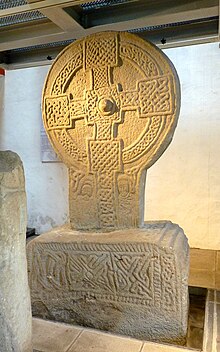Margam Stones Museum
The remainder are Margam Abbey memorials, housed in the upper gallery, and are mainly tomb slabs.
The pre-Norman stones form a distinct local group of early Christian carvings and inscribed text, and are described as one of the most important such collections in Britain.
A squared pillar of Old Red Sandstone, 1.35 metres (4.4 ft) tall, it contains both Latin and Ogham scripts.
Two areas of Ogham script appear, written as notches along the side of the stone, on the same face as the Latin name.
It originates from a nearby mountain location, set into a prehistoric burial mound, where a replica now stands.
[6] It is a stone pillar, 1.01 metres (3.3 ft) high, with four lines of Latin inscription and an incised cross.
It was discovered 'under a hedge' at Cwrt Uchaf Farm in 1857, before being moved to join the Margam collection.
[9] These date from 900 to 1100 AD, and form the great majority of the Margam early Christian collection.
Seven of them are from the immediate environs of Margam, and three are from the same location as the Pillar of Thomas, implying perhaps two pre-Norman monastic establishments in the area, using the local sandstone to create distinctive Celtic stone sculpture.
The cross and stem have intricate lattice patterns with an inscription in insular majuscule script.
[10] The circular head of the cross has been roughly cut back to make it a more even shape for re-use as building material.
[11] Stylistically the splayed arms and wide circular armpits are similar to 10th-century crosses from the north of England.
[11] Date: 10th century The largest of the Margam Stones, and with the most decorative and figurative carvings, the RCAHMW describe it as "the most impressive of the monuments of this category in the county, if not in all Wales".
The shaft includes carved figures flanking the cross, taken to be St John holding his gospel, and the virgin Mary.
Small grave marker In 1147 the Margam monastery was re-founded as a Cistercian Abbey by Robert, 1st Earl of Gloucester and lord of Glamorgan.
With French monks, an English lord and new Abbey buildings, there would have been little or no interest in the earlier monastery, and the early stones are the main evidence that survives.
The Talbot family collected the early Christian Stones in and around the Chapter house, and under the care of the Commissioner of Public Works they were all re-housed in the current museum, including five grave-slabs and an effigy from the pre-reformation period, and four post-reformation memorial slabs.
23, 14th century) and a partial inscription in Welsh '...EV GORWEDD GORPH ELI[ZABETH] .. HON V GLADDWYD ...' ( [here] lies the body of Elizabeth ... who was buried...', (No.

















